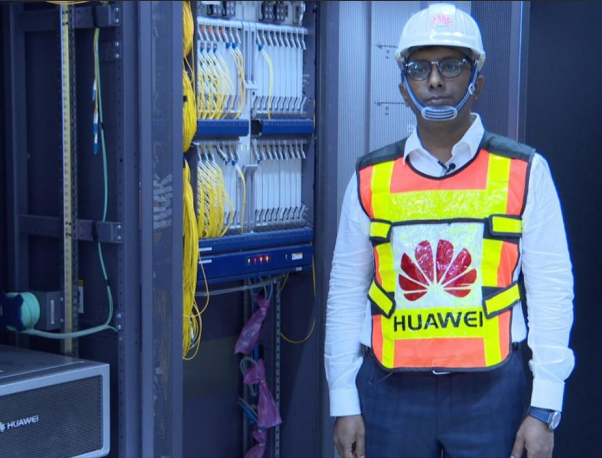
A local worker for the Development of National ICT Infra-Network for Bangladesh Government Phase III, March 2019. (Xinhua)
BEIJING, April 25 (Xinhua) -- In less than half a century since its independence in 1971, Bangladesh has developed from the least developed country to a country with a population of over 160 million and an average annual GDP growth of about 7 percent. Such a fast-growing economy demands infrastructure and industry upgrading in every sector. Chinese companies, with their Internet technology and big data infrastructure, are assisting the country to fulfill the Digital Bangladesh 2021 Vision.
In an obscure building in Bangladesh's capital city Dhaka, the optical transmission and data communication equipment developed by Huawei is working in the data sink node center of the Development of National ICT Infra-Network for Bangladesh Government Phase III. Ye Zuchun, account service manager of the Bangladesh enterprise business department of Huawei Technologies (Bangladesh) Ltd. told the reporter that the equipment in the center collects and transmits data from 32 districts out of the country's 64 districts.
"The optical transmission equipment used for the project is the most advanced in the world, the same as that used in Europe. This project is turning Bangladesh into a digital highland in South Asia," said Ye Zuchun.
The Development of National ICT Infra-Network for Bangladesh Government Phase III, with contract value of 169.6 million U.S. Dollars, is undertaken by Chinese enterprises including Huawei. The Phase III project, based on the Phase I and Phase II projects, is to scale up the existing national government network, to achieve network capacity of 1 Gbps, 10 Gbps and 100 Gbps at city, county, and upazila levels, respectively. The project includes building new networks for some upazilas, strengthening backbone network of high-level administrative divisions, and deploying a national network management platform, including its implementation, integration, network optimization and training services.
Huawei has participated in the Phase II project as the designer and implementation unit of the technical solution. It undertook extending government backbone network to government offices at county level, scaling up the capacity of fundamental data center, and deploying terminal safety management systems and video conferencing systems across the country.
Hisamul Nasir, senior project manager of Huawei Technologies (Bangladesh) Ltd., who has participated in Phase II and Phase III together with Ye Zuchun, said that the project is enabling the fulfillment of Digital Bangladesh 2021 Vision. Up to now, 90 percent of the project has been completed. The project, implemented by the Bangladesh Computer Council, is highly valued by Sheikh Hasina, Prime Minister of Bangladesh, and is under direct guidance of Sajeeb Wazed Joy, Bangladeshi Prime Minister's Information and Communication Technology (ICT) Affairs Adviser. It also has received supports from relevant ministries of Bangladesh.
Through network operations center, Bangladesh's Information & Communication Technology Division can get real-time information about network operations in 32 counties and the subordinate areas. The boosted network speed will significantly promote administrative efficiency at different levels.
The implementation of the project has also trained a wealth of talents for Bangladesh. Kowdr, aged 25, who joined the project after graduation, has quickly grown into an engineer. Ye Zuchun said professional training was offered to local engineers and workers during the implementation of the project. Bangladesh also has gained plenty of experience in planning and implementation of large ICT projects.
Before the completion of the Phase II project, government affairs were mainly communicated through telephone, fax, paper documentaries and face-to-face meetings. When the project was completed, major government departments were equipped with office automation systems, such as video conferencing systems and e-mails. Departments can transfer electronic files between different regions, greatly enhancing administrative efficiency and achieving the initial transformation towards electronic office.
In addition to satisfying the demand for government e-office, the data center under the Phase II project has provided incubation platforms for mobile Internet and software application companies, and helped local Internet-based food-delivering companies, network payment companies and game companies gain remarkable development in recent years.
After the Phase II project was put into service, training on ICT knowledge was provided to local civil servants. However, as the use of the video conferencing systems increased and many ministries and departments hope to get access to government information network, the original design failed to meet the newly-increased needs. The Phase III thus emerges to further improve the relevant system.
The Phase II and Phase III projects are major boosts for the construction of network infrastructure in Bangladesh. With a huge increase in network bandwidth, the Internet industry, application software and ICT-related high-tech industries will usher in fast development, and high-tech industries related to ICT will grow as well.
With a large population, developing education and human resources should be the fundamental orientation of Bangladesh. With advanced ICT infrastructure, Bangladesh is able to develop distance education to increase access to education and "Internet plus healthcare" to promote healthcare. In remote areas without network access, the Phase III project provides network coverage for local people by setting up WiFi networks. With the improvement of ICT infrastructure, more and more people will have their demand on network communications met.
Currently, Bangladesh has a population of over 160 million, half of which are under age of 25. ICT development is an important strategy for Bangladesh to capitalize on its human resources and to eradicate poverty and become prosperous. Although traditional industries like clothing and textile can provide jobs, clothing and food for locals, it is hard for Bangladesh to eradicate poverty and become prosperous. Instead, information technology can help Bangladesh to accomplish industry upgrading, achieve the goal and vision to build a prosperous country. (Contributed by Liu Chuntao, Zhang Ge, edited by Gu Shanshan)




 A single purchase
A single purchase









